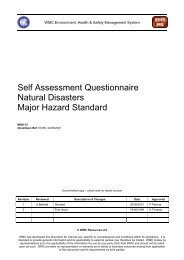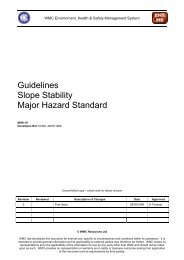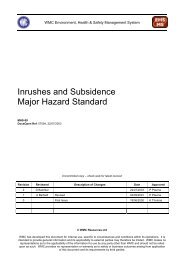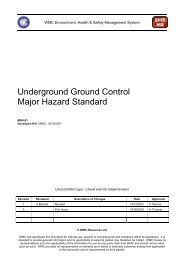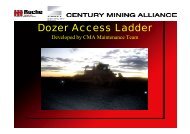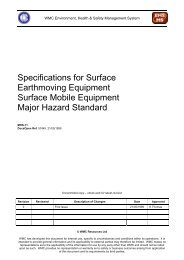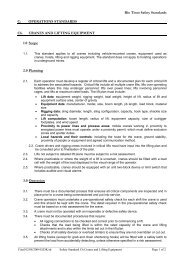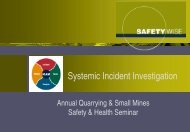Aviation Major Hazard Standard - MIRMgate
Aviation Major Hazard Standard - MIRMgate
Aviation Major Hazard Standard - MIRMgate
You also want an ePaper? Increase the reach of your titles
YUMPU automatically turns print PDFs into web optimized ePapers that Google loves.
<strong>Major</strong> <strong>Hazard</strong> <strong>Standard</strong><br />
MHS 03 - <strong>Aviation</strong> <strong>Standard</strong> documen Revision 3<br />
issued 20 August 2001<br />
** Uncontrolled copy. Use latest revision **<br />
I Specialised Role <strong>Aviation</strong> Services<br />
Introduction<br />
This appendix provides guidance on the preparation<br />
and management of specialised role aviation<br />
services. Such services require a level of training<br />
and flight management additional to that required<br />
for routine flight operations.<br />
These include:<br />
• aerial pipeline inspection patrols<br />
• aerial operations on pastoral stations including<br />
mustering<br />
• helicopter external lifting operations and winching<br />
When planning these operations, guidance should be<br />
obtained from WMC’s <strong>Aviation</strong> Consultants.<br />
Airborne geophysical surveys shall be conducted<br />
in accordance with the International Airborne<br />
Geophysics Safety Association (IAGSA) Safety<br />
Policy Manual. Only members of IAGSA shall<br />
conduct these surveys.<br />
Risk Evaluation<br />
Specialised aviation operations shall be subjected to<br />
a risk evaluation. This should involve the aircraft<br />
operator, the WMC representative coordinating the<br />
work, an aviation consultant appointed by WMC.<br />
and representatives of other groups that may be<br />
directly involved in the operation. The evaluation<br />
shall include but not be limited to :<br />
• Terrain relief and elevation<br />
• Aircraft type and performance<br />
• Aircrew experience and recency<br />
• Aircrew flight and duty times<br />
• Weather conditions, including operational weather<br />
limits<br />
• Identification of hazards associated with the<br />
operational procedures<br />
• Man made obstructions<br />
• Emergency response capability.<br />
The risk evaluation process should result in the<br />
adoption of control measures which will mitigate the<br />
risks to personnel involved in the operation.<br />
Operational Procedures<br />
Detailed operational procedures shall be prepared<br />
for any specialised role flying operation. These<br />
procedures should include but not be limited to the<br />
following areas:<br />
• Description of the scope of the work including<br />
specific WMC contract requirements<br />
• Roles and responsibilities of groups and<br />
individuals<br />
• Description of the area of operations including an<br />
area map showing local hazards<br />
• Aircraft performance, operating procedures,<br />
crewing and flight and duty times<br />
• Provision and management of ground support for<br />
the aircraft operation<br />
• Communications and flight following procedures<br />
• Emergency response including Search and Rescue<br />
procedures<br />
• Airstrips to be used and available within the area<br />
of operations<br />
• Safety and Health management<br />
Aircraft Performance and Crewing<br />
Operating parameters for the aircraft carrying out<br />
the work should be identified. Non-standard<br />
modifications to the aircraft are to be certified by the<br />
relevant aviation regulatory authority. Guidance<br />
should be obtained from WMC’s <strong>Aviation</strong><br />
Consultants on the suitability of the aircraft for the<br />
work planned and the flight environment.<br />
In addition to regulatory minimum instrument<br />
standards and other equipment requirements of the<br />
WMC <strong>Aviation</strong> <strong>Standard</strong>, aircraft used for<br />
specialised roles requiring low level flying should<br />
have shoulder harnesses for all occupants, a clear,<br />
unscratched canopy and appropriate securing<br />
mechanisms for any additional instrumentation.<br />
Aircraft crewing for specialised operations varies<br />
with the nature of the operation, aircraft size and<br />
sophistication, the terrain overflown, the type of any<br />
additional equipment installed and the degree of<br />
monitoring required by that equipment. For low<br />
level operations and operations in mountainous<br />
terrain, pilots (and co-pilots where carried) should<br />
have successfully completed flight training<br />
programmes for both the special role and the<br />
particular flying environment.<br />
Crew experience requirements for specific<br />
specialised flying operations are provided in<br />
relevant sections of this Appendix.<br />
SAF-MHS-03 Rev. 03 Docs: 55221 Issued: 20/08/01 Page 23 of 29







